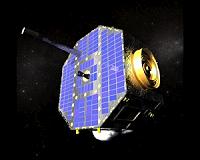 |
Paris, France (SPX) Feb 04, 2010 ESO is releasing a magnificent VLT image of the giant stellar nursery surrounding NGC 3603, in which stars are continuously being born. Embedded in this scenic nebula is one of the most luminous and most compact clusters of young, massive stars in our Milky Way, which therefore serves as an excellent "local" analogue of very active star-forming regions in other galaxies. The cluster also hosts the most massive star to be "weighed" so far. NGC 3603 is a starburst region: a cosmic factory where stars form frantically from the nebula's extended clouds of gas and dust. Located 22 000 light-years away from the Sun, it is the closest region of this kind known in our galaxy, providing astronomers with a local test bed for studying intense star formation processes, very common in other galaxies, but hard to observe in detail because of their great distance from us. The nebula owes its shape to the intense light and winds coming from the young, massive stars which lift the curtains of gas and clouds revealing a multitude of glowing suns. The central cluster of stars inside NGC 3603 harbours thousands of stars of all sorts (eso9946): the majority have masses similar to or less than that of our Sun, but most spectacular are several of the very massive stars that are close to the end of their lives. Several blue supergiant stars crowd into a volume of less than a cubic light-year, along with three so-called Wolf-Rayet stars - extremely bright and massive stars that are ejecting vast amounts of material before finishing off in glorious explosions known as supernovae. Using another recent set of observations performed with the SINFONI instrument on ESO's Very Large Telescope (VLT), astronomers have confirmed that one of these stars is about 120 times more massive than our Sun, standing out as the most massive star known so far in the Milky Way. The clouds of NGC 3603 provide us with a family picture of stars in different stages of their life, with gaseous structures that are still growing into stars, newborn stars, adult stars and stars nearing the end of their life. All these stars have roughly the same age, a million years, a blink of an eye compared to our five billion year-old Sun and Solar System. The fact that some of the stars have just started their lives while others are already dying is due to their extraordinary range of masses: high-mass stars, being very bright and hot, burn through their existence much faster than their less massive, fainter and cooler counterparts. The newly released image, obtained with the FORS instrument attached to the VLT at Cerro Paranal, Chile, portrays a wide field around the stellar cluster and reveals the rich texture of the surrounding clouds of gas and dust.
Share This Article With Planet Earth
Related Links ESO VLT Stellar Chemistry, The Universe And All Within It
 Giant Ribbon At The Edge Of The Solar System: Mystery Solved
Giant Ribbon At The Edge Of The Solar System: Mystery SolvedHuntsville AL (SPX) Jan 18, 2010 Last year, when NASA's IBEX (Interstellar Boundary Explorer) spacecraft discovered a giant ribbon at the edge of the solar system, researchers were mystified. They called it a "shocking result" and puzzled over its origin. Now the mystery may have been solved. "We believe the ribbon is a reflection," says Jacob Heerikhuisen, a NASA Heliophysics Guest Investigator from the University of Ala ... read more |
|
| The content herein, unless otherwise known to be public domain, are Copyright 1995-2010 - SpaceDaily. AFP and UPI Wire Stories are copyright Agence France-Presse and United Press International. ESA Portal Reports are copyright European Space Agency. All NASA sourced material is public domain. Additional copyrights may apply in whole or part to other bona fide parties. Advertising does not imply endorsement,agreement or approval of any opinions, statements or information provided by SpaceDaily on any Web page published or hosted by SpaceDaily. Privacy Statement |